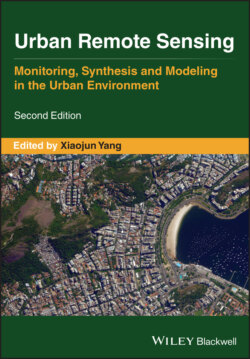Читать книгу Urban Remote Sensing - Группа авторов - Страница 30
2.2 THREE‐DIMENSIONAL (3D) GEOSPATIAL DATA FOR URBAN REMOTE SENSING
ОглавлениеWhile 3D data can be generated from remotely sensed imagery by way of photogrammetric techniques (e.g. photogrammetric bundle‐block adjustment, Structure from Motion computer vision), active remote sensing technologies, such as lidar and radar, provide the bulk of the 3D geospatial data for Earth's surface. With regard to these 3D data, two characteristics become critical for urban remote sensing of built‐up volume and change: (i) spatial resolution and coverage, or the level of detail, allows discrimination of individual buildings and other infrastructure (i.e. highway overpasses, bridges, levees, etc.) for built‐up volume calculation over extensive urban areas, and (ii) temporal resolution, or data collection frequency, enables change detection analyses through multi‐temporal comparisons (e.g. annual data across a decadal record). Correspondingly, Figure 2.1 shows previous, current, and future remotely sensed 3D data sources organized by spatial and temporal resolutions, and sized by swath (i.e. width of data collection pass by satellite or airborne platform).
FIGURE 2.1 Current, former, and future 3D data sources for Earth observation. Airborne lidar provide very high spatial resolution but with sporadic temporal frequency. SARs such as COSMO‐SkyMed and TanDEM‐X provide the best options with both high temporal and spatial resolution data. Other SARs are planned to launch in future years, which will provide a multidecadal 3D record from QuikSCAT in 2000 to COSMO‐SkyMed and TanDEM‐X and eventually NISAR and LOTUSats 1 and 2 in the 2020s.
Airborne discrete‐return lidar data provide high spatial resolution data (see Figure 2.1) but is collected on a nonregular basis over small areas due to high cost. Lidar data acquisition is expensive and, regarding multi‐temporal data capture of particular locations for change analyses, is often not repeated for several years unless a specific funding source or project is in place. Multi‐temporal lidar analyses, therefore, commonly need to integrate lidar data from a variety of sources with varying point densities (Gamba et al. 2005). In the United States, government agency‐collected lidar data are often publicly available and free to download, but this is not always the case with other data collectors and holders. Some of these lidar data sources include the following:
Federal governmentUnited States Geological Survey (USGS) through the 3D Elevation Program (3DEP) for topographic mapping National Oceanic and Atmospheric Administration (NOAA) for coastal mappingFederal Emergency Management Agency (FEMA) for flood risk mapping
State governmentMichigan Statewide Authoritative Imagery & LiDAR (MiSAIL) programOregon Department of Geology and Mineral Industries Lidar Program
Regional and local governmentCapital Area Council of Governments (CAPCOG), a 10 county collaboration in central TexasCity of New York (topographic and bathymetric lidar collections in 2017)
Unfortunately, lidar data are not collected regularly in many countries worldwide or not accessible due to potential classified military operations; hence, the desire for spaceborne lidar and/or other data collection avenues for 3D data such as radar platforms. Spaceborne lidar platforms such as ICESat‐2 and GEDI offer open, free lidar data with increased repeatability though not to the level of spatial detail of the airborne options previously discussed and with extended repeat acquisition time (see Figure 2.1).
Remote sensing analyses increasingly require higher/finer spatial and temporal resolutions along with large swaths that realistically can only all be provided by spaceborne radar platforms, which attests to the significance of integration of radar data including Synthetic Aperture Radar (SAR) into analyses. To date and for the foreseeable future, radar platforms/sensors provide ample spatial and temporal resolution data for urban built‐up analysis compared to lidar alternatives (e.g. airborne lidar, GEDI, ICESat‐2). QuikSCAT SeaWinds scatterometer data have proven effective at estimating 3D build‐up within urban environments though at relatively coarse spatial and temporal resolutions (Nghiem et al. 2017; Mathews et al. 2019). Unfortunately, QuikSCAT is no longer operating while fully calibrated backscatter data at Level‐1B have not yet become completely and freely available from international satellite scatterometers (e.g. Oceansat‐2 in 2009–2014, HY‐2A in 2011–present, and SCATSAT‐1 in 2016–present). Subsequently, SAR platforms, of which several are now operating (or have operated over the past several decades) and with many future missions are planned such as NISAR and LOTUSat 1 and 2, provide the most promising 3D data option for future urban remote sensing analyses. SAR data options (e.g. COSMO‐SkyMed [CSK], TanDEM‐X [TDX], Sentinel‐1) too, as shown in Figure 2.1, provide both high spatial and temporal resolution data for highly detailed multi‐temporal assessments.
